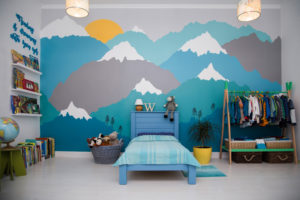
Do you want to add unique personality to a kids’ room, living room or even your back fence? Consider a wall mural. These painted frescoes allow you to customize your space, choosing colors, styles and themes to match your style preferences perfectly.
Supplies You’ll Need
Whether you’re painting an indoor or outdoor wall mural, you’ll need the same supplies. These are:
- Brushes of different sizes and shapes
- Cleaner for your brushes
- Ladder
- Paint
- Paint roller
- Paint sprayer (for outdoor surfaces)
- Paper towels or rags
- Projector for projecting the mural to scale
- String for measuring a grid (if a projector isn’t available)
For indoor murals, any interior house paint will do. For high-traffic or humidity-prone areas, consider a high-gloss latex.
Outdoor murals require a different type of paint than indoor murals. Look for acrylic paints made for outdoor applications. These paints also form the best bond to masonry or cement surfaces.
You can also use regular spray paint on outdoor murals, but one can of spray paint doesn’t cover much wall surface. Instead, get a paint sprayer made for acrylic paint. This will let you paint faster and blend colors more easily on large surfaces.
How to Paint a Wall Mural Inside
Here are the steps for painting a wall mural indoors.
Prep Your Wall
As with any indoor painting project, the first step is to prep the walls. Your ultimate goal: to turn your wall into a clean, smooth canvas. Start by patching any holes or dings. Then sand* the surface smooth. Once that’s done, prime the wall, wait 24 hours and then paint the wall a uniform base color. Wait another 24 hours before going to the next step so that the paint is fully dry.
Scale the Design
Next, scale your design – that means fitting your small design to the wall you’re painting the mural on. There are a few ways to do this.
- The easiest way is to project it on the wall with a projector. Then you can trace your design directly on the wall with pencil, chalk or paint.
- Or, you can break your drawing into a grid, where one square on the drawing equals a square on the wall. This will vary in size based on the wall. Then break the wall into a grid using your string to measure and draw equal squares onto the wall. Then fill in the grid with your design.
- If you’re an experienced illustrator, you can freehand it. This isn’t a good option if you’re doing a mural that requires you to exactly match the client’s artwork.
Draw an Outline
Now the fun starts! Start by filling in the larger designs first, backing up often to see how it looks from a distance. This will help you keep the perspective correct.
Layer in the Details
Once the big designs are in place, can go back and add detail. Use smaller brushes as you work on smaller features.
How to Paint a Mural Outside
You follow similar steps to paint an outdoor mural. Because outdoor walls may be larger than indoor ones, you’ll need to plan and scale the design before you paint. Consider the weather when you’re planning, as well, since you can’t paint in the rain or extreme cold.
Prepping outdoor walls can be harder than indoor ones, since there are other considerations (larger holes, moss, mold, etc.). Take extra time to clean and prep the wall, or your mural will chip and fade more quickly. Use self-priming paints to save time.
Follow the same steps for scaling and painting. For outdoor murals, add a layer of protection with a coat of non-yellowing, weather-resistant varnish.
If you love murals, but painting them isn’t your thing, give our custom interior painting team a call. They’ll create something beautiful and unique – just for you. You can also get a color consultation and browse trending colors any time, day or night.
*WARNING! If you scrape, sand, or remove old paint, you may release lead dust. LEAD IS TOXIC. EXPOSURE TO LEAD DUST CAN CAUSE SERIOUS ILLNESS, SUCH AS BRAIN DAMAGE, ESPECIALLY IN CHILDREN. PREGNANT WOMEN SHOULD ALSO AVOID EXPOSURE. Wear a NIOSH-approved respirator to control lead exposure. Clean up carefully with a HEPA vacuum and a wet mop. Before you start, find out how to protect yourself and your family by contacting the National Lead Information Hotline at 1-800-424-LEAD or log on to www.epa.gov/lead.